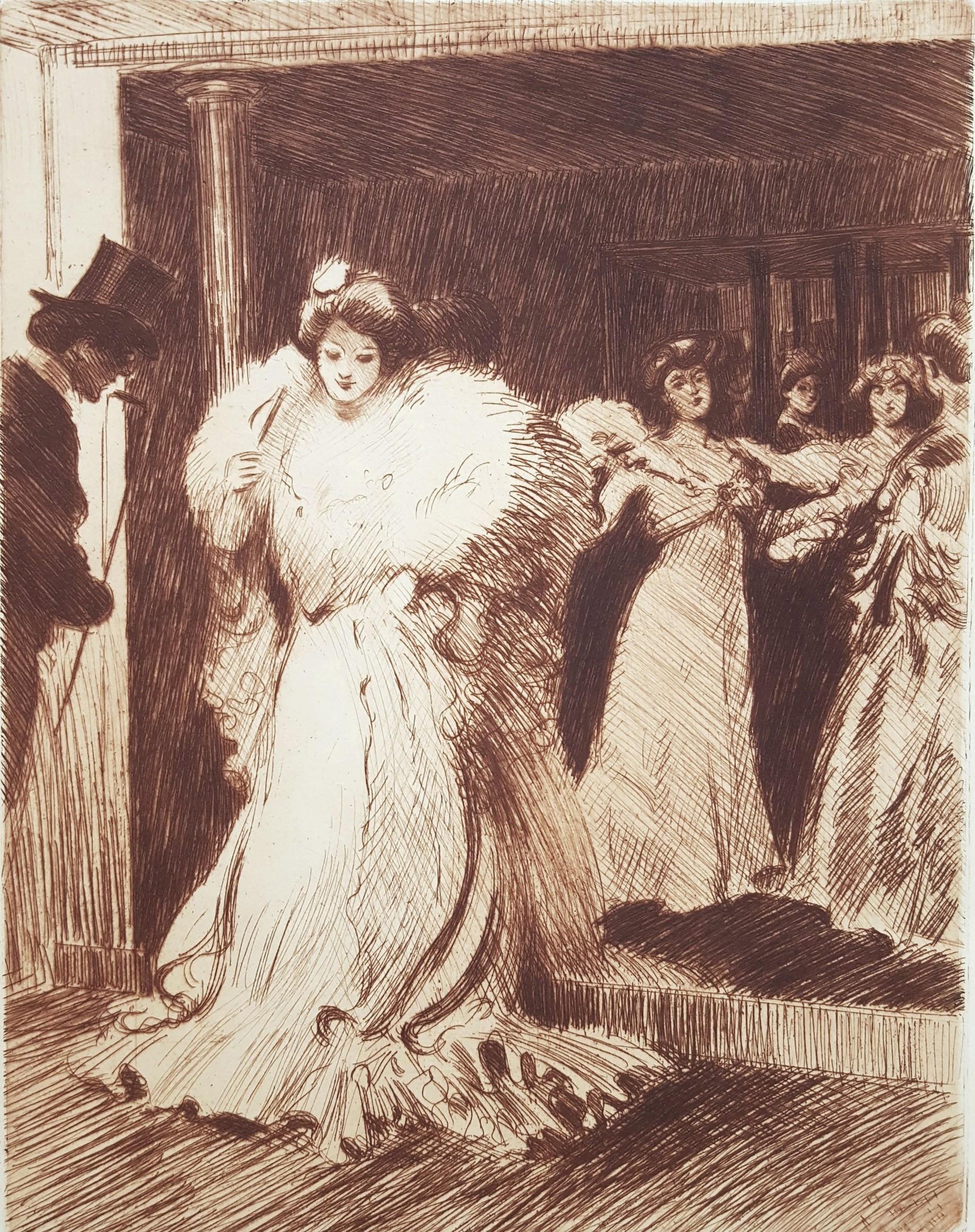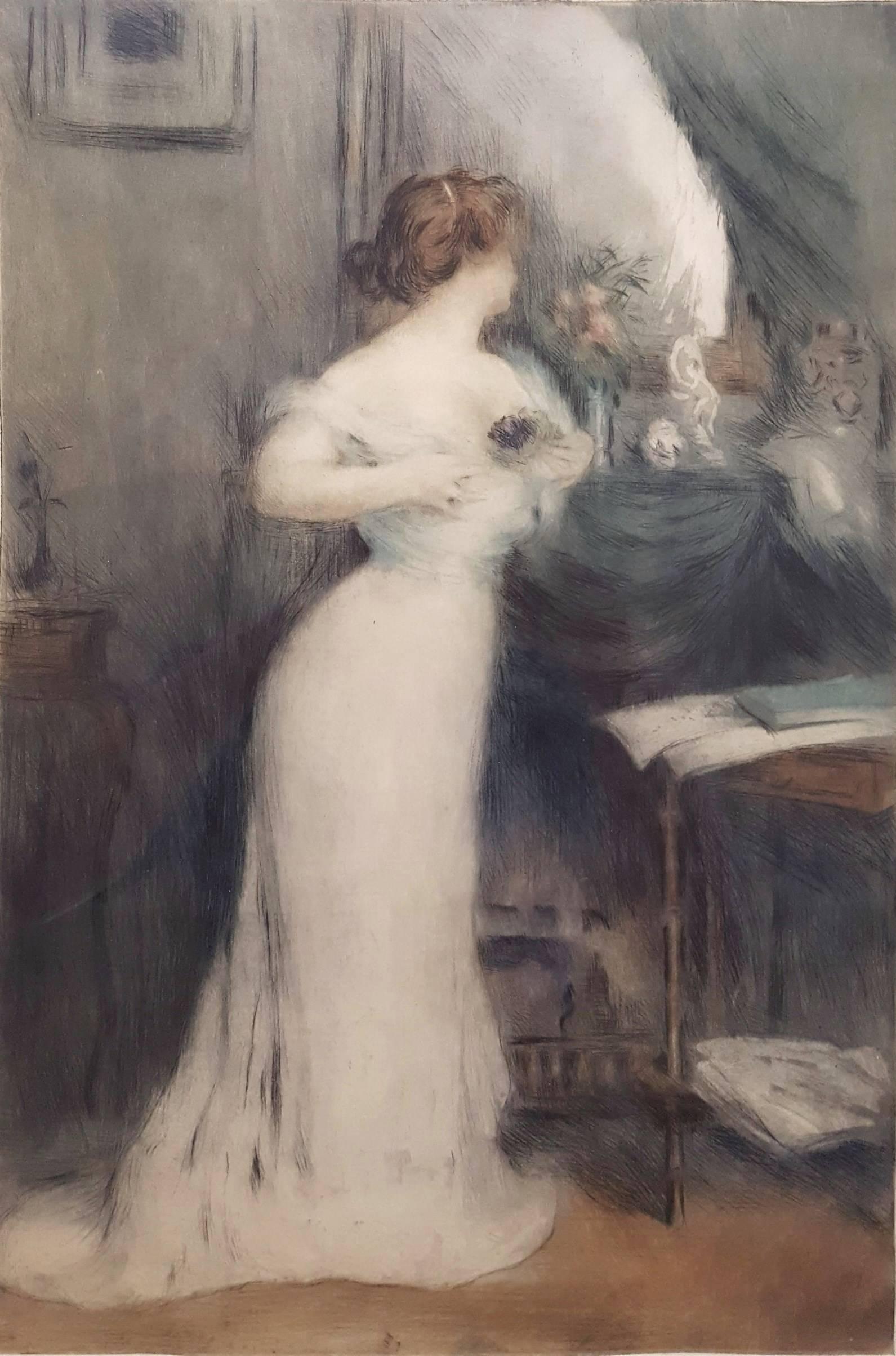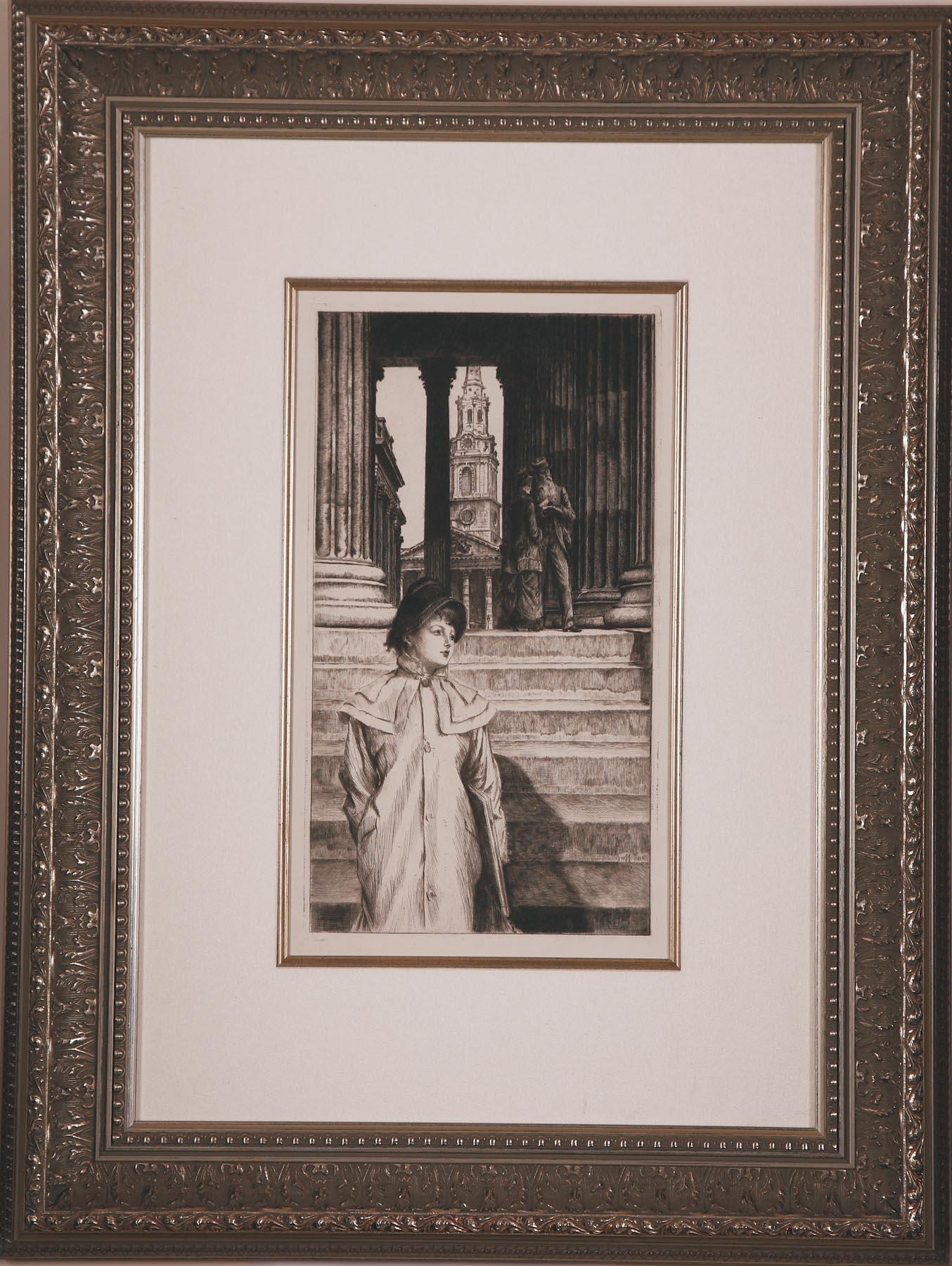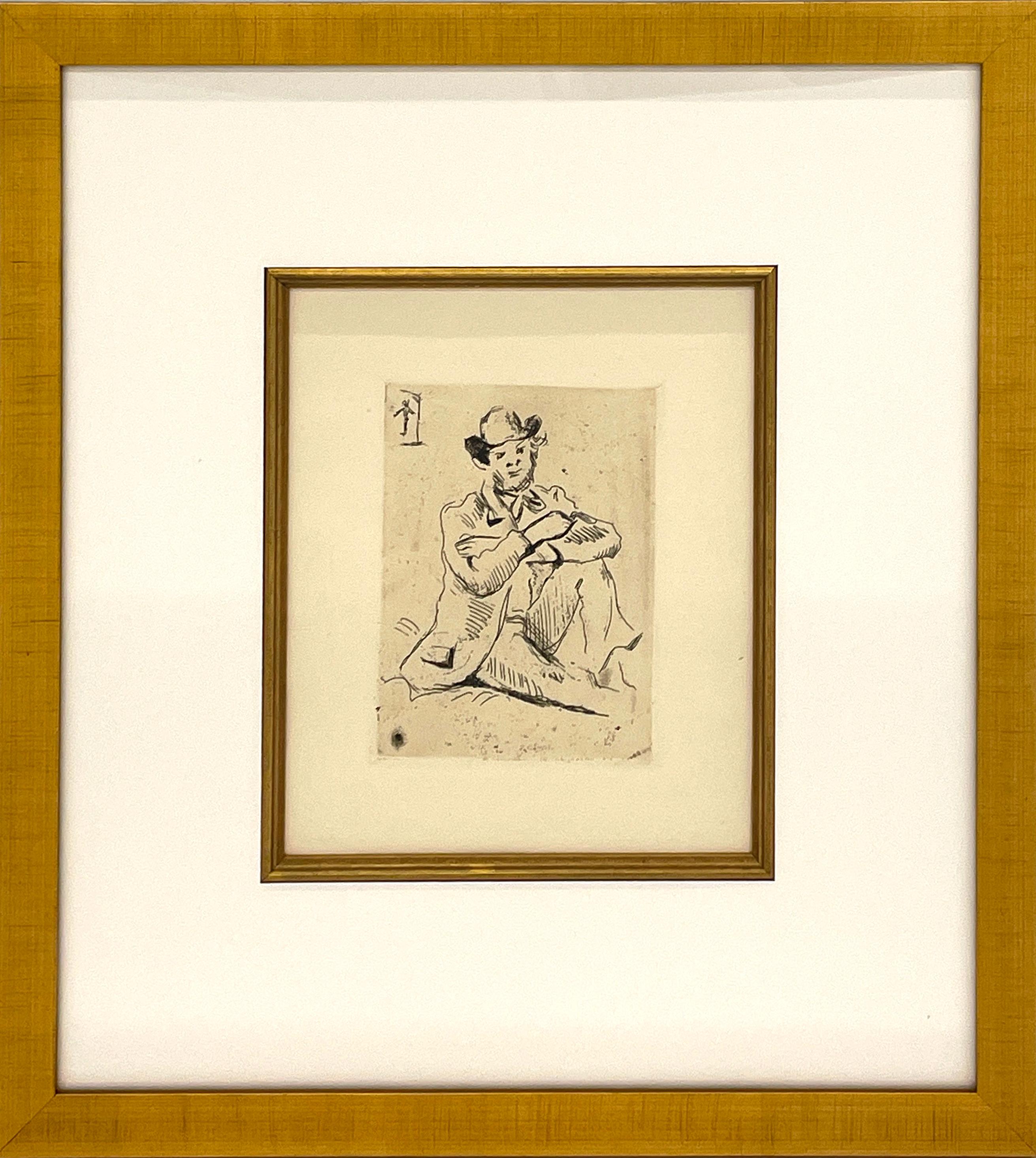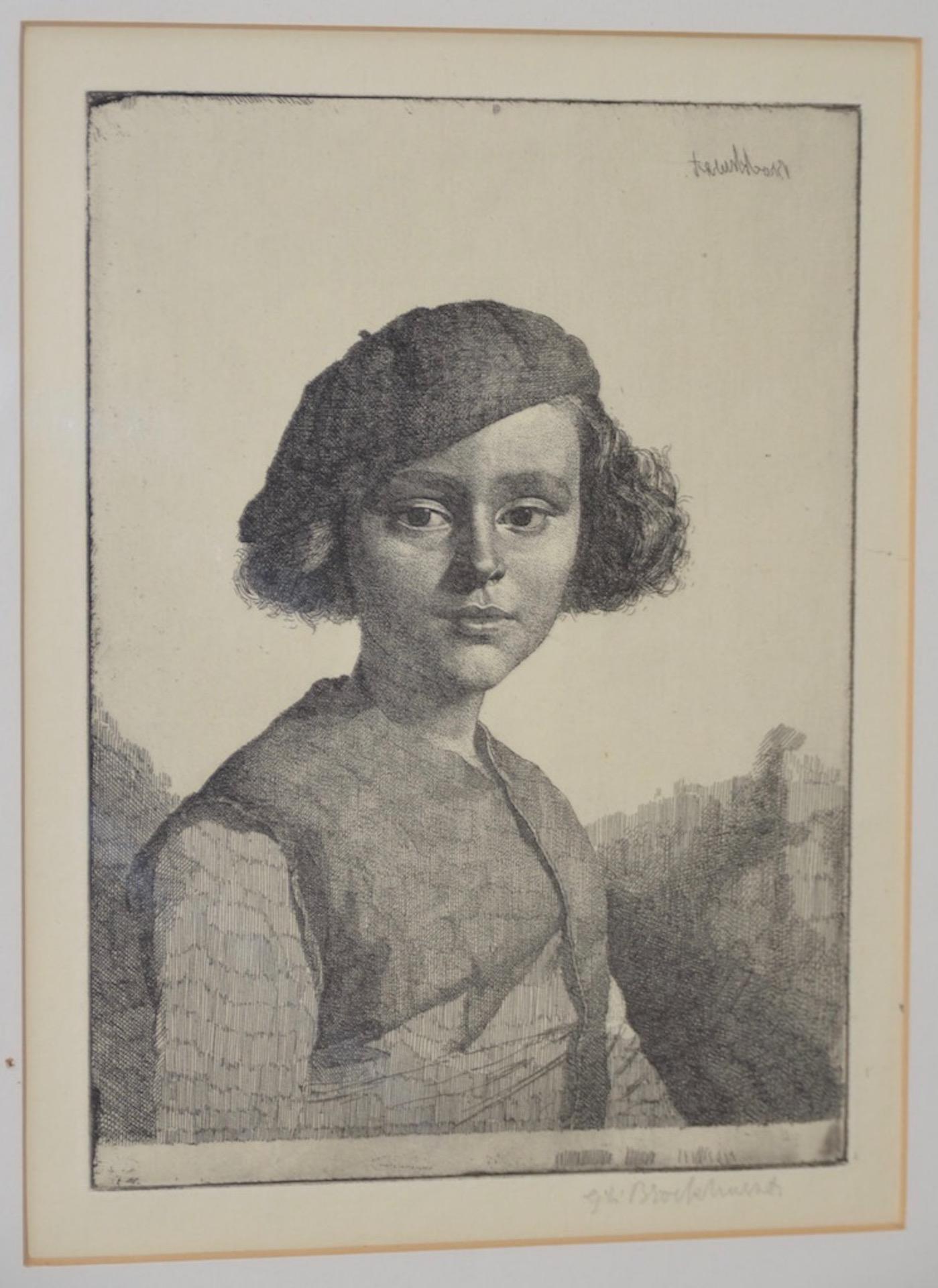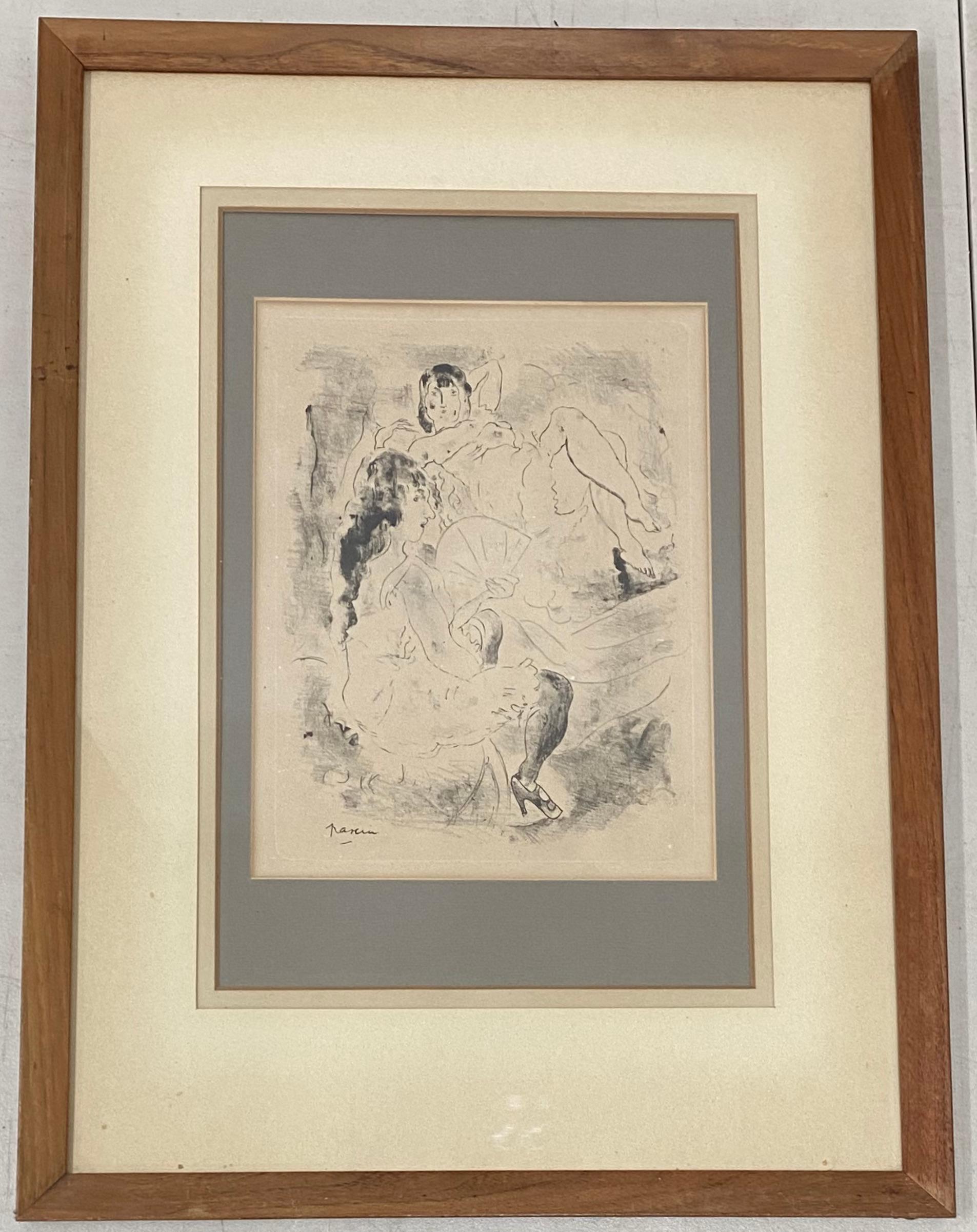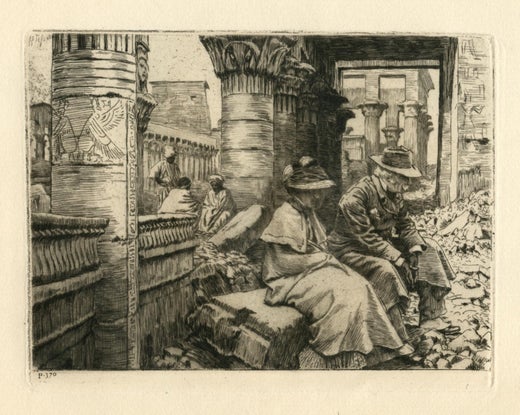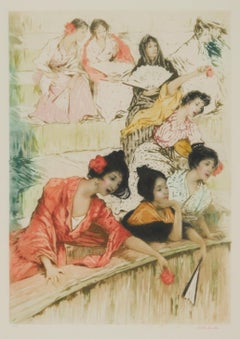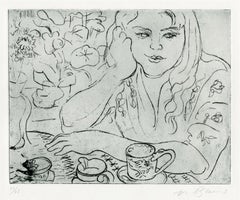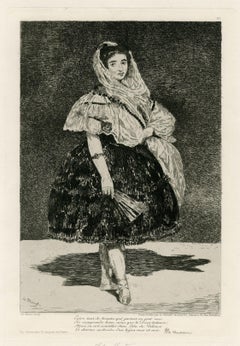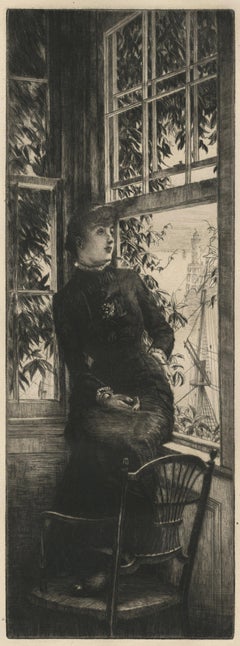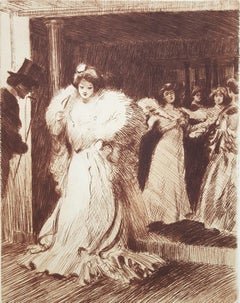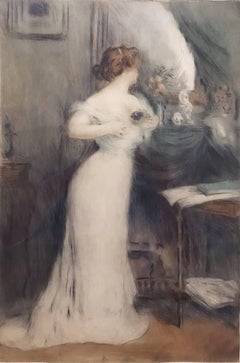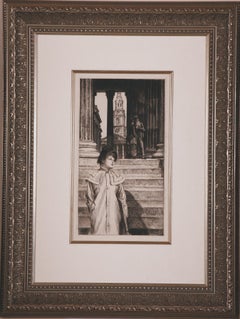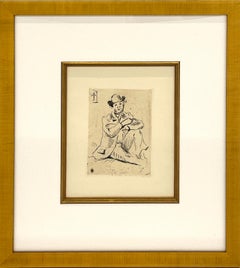Articles similaires à L'enfant prodigue: en pays etranger (The Prodigal Son: In Foreign Climes)
Vous voulez plus d'images ou de vidéos ?
Demander au vendeur plus d'images ou de vidéos
1 sur 10
James Jacques Joseph TissotL'enfant prodigue: en pays etranger (The Prodigal Son: In Foreign Climes)1881
1881
À propos de cet article
L'enfant prodigue: en pays etranger (The Prodigal Son: In Foreign Climes)
Etching, 1881
Unsigned (as usual for this state)
From: L'enfant prodigue, (The Prodigal Son, five plates)
Edition: 400 in this state
Total edition: 500
Plate size: 12-1/4 x 14-3/4"
Sheet size: 19 5/8 x 24 1/2 "
Condition: Excellent, usual aging for 100 year old paper
Provenance: Heirs of Edmund Sagot, Paris
Reference: Wentworth 59 ii/II, with the title and caption
Tissot was the recent subject of a major retrospective organized by the Musee D'Orsay, Paris and the Fine Arts Museum of San Francisco. The following is excerpted from their press release:
"James Tissot (1836–1902) was one of the most celebrated French artists during the 19th century, yet he is less known than many of his contemporaries today. Presenting new scholarship on the artist’s oeuvre, technique, and remarkable life, James Tissot: Fashion & Faith provides a critical reassessment of Tissot through a 21st-century lens. The exhibition, co-organized by the Fine Arts Museums of San Francisco and the Musées d’Orsay et de l’Orangerie, Paris, includes approximately 60 paintings in addition to drawings, prints, photographs, and cloisonné enamels, demonstrating the breadth of the artist’s skills. The presentation at the Legion of Honor is the first major international exhibition on Tissot in two decades and the first ever on the West Coast of the United States.
“The work of James Tissot provides a fascinating lens onto society at the dawn of the modern era. Long recognized as a keen observer of contemporary life and fashion, this exhibition brings new light to his narrative strengths and his skill in portraying the emotional and spiritual undercurrents that exist below surface appearances,” states Thomas P. Campbell, Director and CEO of the Fine Arts Museums of San Francisco. “Continuing the Fine Arts Museums’ tradition of contributing original scholarship around key works in our collection, we are thrilled to introduce the perspective of this enigmatic, prolific artist in the first exhibition of his work to take place on the West Coast.”
Tissot’s works have been highly sought after for US collections, and, as such, James Tissot: Fashion & Faith draws from the rich holdings of the Fine Arts Museums of San Francisco; the J. Paul Getty Museum, Los Angeles; the National Gallery of Art, Washington, DC; and numerous private collections, in addition to private and public collections throughout Europe and Canada, including those of Tate, London; the Musées d’Orsay et de l’Orangerie; the Petit Palais, Musée des Beaux-Arts de la Ville de Paris; the Musée d’Arts de Nantes; the National Gallery of Canada, Ottawa; and the Musée des Beaux-Arts de Montréal. In addition, new findings on Tissot’s materials and painting technique—resulting from an extensive, unprecedented study of Tissot paintings and led by the paintings conservation department at the Fine Arts Museums—are revealed in the exhibition. The study was undertaken in collaboration with the Northwestern University/ Art Institute of Chicago Center for Scientific Studies in the Arts (NU-ACCESS) and the Centre for Research and Restoration of the Museums of France.
Arranged chrono-thematically, James Tissot: Fashion & Faithwill trace the extraordinary turns of the artist’s life, as he consistently defied traditional conventions, both professionally and personally. A Frenchman who started out painting medievalized scenes from history and literature, Tissot maintained a complicated friendship with mentee Edgar Degas, went on to adopt an Anglicized version of his name; Jacques, and spent a decade as an expatriate in London, immersing himself in and chronicling modern society. For a time, he ventured into a love affair with the young divorcée Kathleen Newton, who became his model and muse, but, after her tragic premature death, he returned to Paris and spent long periods of productive retreat at his family estate in the French countryside, nurturing a growing, deep commitment to religion.
Tissot’s career spanned the English Channel, garnering commercial and critical success both in London and Paris. Though invited by Degas to exhibit with the Impressionists, Tissot declined. He turned to social events and balls, painting metropolitan life with great attention to detail, humor, and pathos. Upon close study, even his most ebullient society pictures reveal rich and complex commentary on Belle Époque culture, religion, fashion, and politics. The exhibition will include many key modern-life works from his time in London and Paris, such as The Ball on Shipboard (1874), London Visitors (ca. 1874), Holyday (also known as The Picnic; 1876), The Prodigal Son in Modern Life suite (1882), and examples from the La Femme à Paris series (1883–1885).
“James Tissot was technically gifted across a variety of media and he experimented with major trends in art, including Aestheticism and Japonisme, yet his work defies classification and traditional labels,” notes Melissa Buron, exhibition curator and Director of the Art Division at the Fine Arts Museums of San Francisco. “For the past few years, my colleagues and I have been on the trail of Tissot, re-examining works and uncovering previously unpublished information that provides insight into his career, including his sales notebook (carnet de ventes) and hundreds of photographs. Drawing from our findings, James Tissot: Fashion & Faith provides new perspectives on where and how Tissot should be considered in the 19th-century canon.”
As was popular during the late 19th century, Tissot dabbled in mysticism and attended Spiritualist séances. His famous mezzotint from the Fine Arts Museums’ collection, The Apparition (1885), depicts the ghost of Kathleen Newton with a spirit guide as they reportedly appeared to Tissot during a séance. This work and the painting on which it is based—long thought to be lost or destroyed until it was rediscovered in the course of researching this project—are both on view in the exhibition.
Though less is known about the last two decades of Tissot’s life, new scholarship has recently shed light on the final 20 years of his career. During that time, he made three trips to the Holy Land and produced hundreds of watercolors to illustrate the Bible. Wildly popular during Tissot’s lifetime, these religious images became known as the “Tissot Bible” and have since influenced filmmakers from D. W. Griffith (Intolerance, 1916) to William Wyler (Ben-Hur, 1959), as well as Steven Spielberg and George Lucas (Raiders of the Lost Ark, 1981). A selection of biblical watercolors have been lent to the exhibition from the Brooklyn Museum and the Jewish Museum, New York.
Tissot also utilized the relatively new medium of photography by painting from photographs and recording many of his works as well as his home, family, and friends in carefully arranged albums. Photographs from the Fine Arts Museums’ collection in the exhibition, along with recently discovered, never-before-published photographs and a sales notebook published for the first time in the exhibition catalogue, provide a window into Tissot’s life and career, rendering him an artist worthy of reexamination in the 21st century."
- Créateur:James Jacques Joseph Tissot (1836-1902, Français)
- Année de création:1881
- Dimensions:Hauteur : 31,12 cm (12,25 po)Largeur : 37,47 cm (14,75 po)
- Support:
- Mouvement et style:
- Période:
- État:
- Adresse de la galerie:Fairlawn, OH
- Numéro de référence:Vendeur : FA66891stDibs : LU14016413342
James Jacques Joseph Tissot
Jacques Joseph Tissot (français : [tiso] ; 15 octobre 1836 - 8 août 1902), anglicisé en James Tissot (), est un peintre et illustrateur français. Il a été un peintre à succès de la société parisienne avant de s'installer à Londres en 1871. Il est devenu célèbre en tant que peintre de genre représentant des femmes habillées à la mode dans diverses scènes de la vie quotidienne. Il a également peint des scènes et des personnages de la Bible.
À propos du vendeur
5,0
Vendeur reconnu
Ces vendeurs prestigieux sont des leaders du secteur. Ils représentent le summum en matière de qualité et de design.
Vendeur Or
Vendeurs premium dont la note est supérieure à 4,3 et le délai de réponse de 24 heures maximum
Établi en 1978
Vendeur 1stDibs depuis 2013
789 ventes sur 1stDibs
Temps de réponse habituel : <1 heure
Associations
International Fine Print Dealers Association
- ExpéditionRecherche du devis...Expédition depuis : Fairlawn, OH
- Politique des retours
Certaines parties de cette page ont été traduites automatiquement. 1stDibs ne garantit pas l'exactitude des traductions. L'anglais est la langue par défaut de ce site web.
Garantie d'authenticité
Bien qu'il soit peu probable que la situation se présente, dans le cas où vous rencontreriez un problème d'authenticité d'un article, contactez-nous dans un délai d'un an pour obtenir un remboursement intégral. DétailsGarantie de remboursement
Si votre article n'est pas conforme à la description, est endommagé pendant le transport ou ne vous est pas livré, contactez-nous sous 7 jours pour obtenir un remboursement intégral. DétailsAnnulation sous 24 heures
Vous disposez d'un délai de 24 heures pour annuler votre achat sans motif.Des vendeurs professionnels agréés
Nos vendeurs de renommée mondiale doivent respecter des normes strictes en matière de service et de qualité, afin de préserver l'intégrité de nos fiches produit.Garantie d'alignement des prix
Si vous constatez qu'un autre vendeur a mis en vente le même article à un prix inférieur sur un autre site, nous nous alignerons sur ce prix.Livraison en toute confiance à l'international
Notre réseau de transporteurs de premier ordre propose des options d'expédition spécialisées dans le monde entier, y compris des livraisons personnalisées.Plus d'articles de ce vendeur
Tout afficherA la Corrida
A la Corrida
Aquatinte en couleur, C.C. 1900
Signé "Osterlind" en bas à droite au crayon rouge
Annoté : "No. 96" au crayon en bas à gauche
Edition : environ 100
Publié par Sagot, Par...
Catégorie
Début des années 1900, Impressionnisme, Estampes - Figuratif
Matériaux
Aquatinte
Daureen, II
Par Nell Blaine
Daureen, II
Gravure, 1969
Signé au crayon en bas à droite
Edition : 28 (17/28)
Condit : Excellent
Deux charnières de l'ancien passe-partout
Blaine a étudié la gravure à l'Atelier 17 ...
Catégorie
années 1960, Impressionnisme, Estampes - Figuratif
Matériaux
Eau-forte
1 200 $US
Lola De Valence
Par Édouard Manet
Lola De Valence
Gravure, 1862
Signé dans la plaque en bas à gauche : "Ed Manet"
Imprimé sur papier chine collee, sans filigrane
D'après la première édition, publiée par Cadart et Luq...
Catégorie
années 1860, Impressionnisme, Estampes - Figuratif
Matériaux
Eau-forte
4 000 $US
Au bord de la mer
Par James Jacques Joseph Tissot
Au bord de la mer
Gravure et pointe sèche, 1880
Signé dans la plaque au milieu du bord gauche (voir photo)
Edition : c.I.C.
Une impression très riche, pleine de bavures et de contras...
Catégorie
années 1880, Impressionnisme, Estampes - Figuratif
Matériaux
Eau-forte
The Prodigal Son : en pays etranger (L'enfant prodigue : en pays etranger)
Par James Jacques Joseph Tissot
The Prodigal Son : en pays etranger (L'enfant prodigue : en pays etranger)
Gravure, 1881
Non signé (comme d'habitude pour cet état)
D'après : L'enfant prodigue, (cinq planches)
Editi...
Catégorie
années 1880, Impressionnisme, Estampes - Figuratif
Matériaux
Eau-forte
Trois Esquisses de maternité (Trois études de maternité)
Par Pierre Auguste Renoir
D'après Pierre Auguste Renoir (1841-1919)
Trois Esquisses de maternité
Héliogravure avec eau-forte sur papier vélin, 1893
Non signé tel que publié
Edition 1000, il y a aussi 100 sur ...
Catégorie
années 1890, Impressionnisme, Estampes - Figuratif
Matériaux
Eau-forte
Suggestions
L'Avant-Foyer de l'Opera /// Gravure impressionniste française Figurative Lady Man
Par Tony Minartz
Artistics : Tony Minartz (français, 1873-1944)
Titre : "L'Avant-Foyer de l'Opéra".
Portfolio : Revue de l'Art Ancien & Moderne
*Issued unsigned
Année : 1903
Support : Gravure originale sur papier vergé crème
Edition limitée : Inconnu
Imprimante : Inconnu
Éditeur : Revue de l'Art Ancien & Moderne, Paris, France
Encadrement : Récemment encadré dans une moulure traditionnelle or et noire avec un passe-partout 100% coton.
Dimensions du cadre : 18.63" x 16.38"
Taille de la feuille : 12" x 9"
Taille de l'image : 9" x 7.25"
Condit : En excellent état.
Notes :
Imprimé en une couleur : bistre.
Cette revue a été fondée en 1897 dans la continuité de la revue Les Beaux-Arts publiée entre 1861 et 1865 ; Jules Comte, le fondateur, intitule son premier numéro Les Beaux-Arts - Revue nouvelle puis change le titre en La Revue de l'art ancien et moderne. Jules Comte a dirigé la revue jusqu'à sa mort en 1912. Raymond Woog prend la relève et reste directeur provisoire jusqu'au début de la guerre en juillet 1914. En 1919, André Januari reprend cette revue et en est le directeur jusqu'en décembre 1937, date du dernier numéro (publié en janvier 1938). Entre-temps, elle publie le Bulletin d'art ancien et moderne, qui a acquis une certaine notoriété dans la communauté.
Biographie :
Tony Minartz, pseudonyme d'Antoine Guillaume, né le 8 avril 1873 à Cannes et mort dans cette ville le 13 décembre 1944 est un peintre, dessinateur, illustrateur et graveur français.
Peintre autodidacte, Tony Minartz commence à se faire connaître en 1896 en exposant des toiles au Salon de la Société nationale des beaux-arts, puis décore le théâtre Pompadour de panneaux peints pour les défilés de mode " Grand Guignol ", dirigés par L. Darthenay. En 1903, Henri Béraldi , avec qui il a travaillé, fait son éloge dans Le Journal de l'art ancien et moderne, en écrivant que " c'était il y a trente ans ", et qu'il a reçu les conseils de Paul Renouard pour se former à la technique de l'eau-forte ; Béraldi ajoute que ses sujets de prédilection sont " Paris la nuit Paris la nuit, toujours. " Minartz leur donne également quelques hauts faits remarquables dans Le Journal de l'art ancien et moderne jusqu'en 1910 : bals, cafés-concerts, parisiennes dans leurs plus belles robes, mais aussi music-halls, salles de spectacles, restaurants, grands et petits théâtres, sont les lieux de prédilection de ses compositions.
Sa période fertile semble se terminer en 1914. Outre le Salon national, Minartz expose à Paris à la galerie Bartholomé (1903), à la Vie indépendante (1905, 1906) et à la galerie Devambez (1909) et reçoit les Palmes académiques . Il collabore à l'occasion avec des périodiques illustrés comme L'Almanach des sports (Ollendorff, 1899), ou satiriques comme Gil Blas et L'Assiette au beurre . Il présente également quelques partitions et un certain nombre de livres de bibliophilie.
Durant les années 1900 et 1910, il travaille pour le couturier Jacques Doucet...
Catégorie
Début des années 1900, Impressionnisme, Estampes - Figuratif
Matériaux
Papier vergé, Intaille, Eau-forte
Tony MinartzL'Avant-Foyer de l'Opera /// Gravure impressionniste française Figurative Lady Man, 1903
350 $US Prix de vente
54 % de remise
Le Bouquet de Violettes (Le Bouquet de Violets) /// Figurative Impressionniste
Par Manuel Robbe
Artistics : Manuel Robbe (français, 1872-1936)
Titre : "Le Bouquet de Violettes".
*Signé par Robbe au crayon en bas à droite
Année : 1903
Support : Gravure originale colorée à la mai...
Catégorie
Début des années 1900, Impressionnisme, Estampes - Figuratif
Matériaux
Eau-forte, Aquatinte, Aquarelle, Papier vergé, Intaille
1 200 $US Prix de vente
70 % de remise
« Le Portique de la Galerie Nationale à Londres », gravure de Tissot
Par James Jacques Joseph Tissot
TISSOT, JAMES JACQUES JOSEPH
(1836 - 1902)
"Le Portique de la Galerie Nationale à Londres"
(Le portique de la National Gallery, Londres)
Wentwor...
Catégorie
Fin du XIXe siècle, Impressionnisme, Estampes - Figuratif
Matériaux
Eau-forte
Portrait de Guillaumin (avec le pendu)
Par Paul Cézanne
CEZANNE, PAUL
(1841 - 1906)
Portrait de Guillaumin (avec le pendu)
A.I.C. C. 1873
Gravure à l'eau-forte
Seul État connu, 1000 exemplaires
Tel que publié dans Die Impression...
Catégorie
années 1870, Impressionnisme, Estampes - Figuratif
Matériaux
Eau-forte
Gerald Brockhurst (1890-1978) "Fabian" Gravure au crayon signée par Gerald Brockhurst vers 1921
Par Gerald Leslie Brockhurst
Gerald Brockhurst (1890-1978) Gravure signée au crayon "Fabian" c.1921
Belle gravure à l'eau-forte de l'éminent artiste Gerald Brockhurst.
Titré "Fabian" d'une édition de 76.
Cett...
Catégorie
Début du 20ème siècle, Impressionnisme, Estampes - Portrait
Matériaux
Eau-forte
Jules Pascin (Français, 1885-1930) « Two Women Reclining », gravure originale de Jules Pascin vers 1920
Par Jules Pascin
Jules Pascin (Français, 1885-1930) "Deux femmes couchées" Gravure originale C.1920
Dimensions de la plaque : 9" de large x 12" de haut
Dimensions du cadre : 19,5" de large x 26,5" ...
Catégorie
Début du 20ème siècle, Impressionnisme, Estampes - Figuratif
Matériaux
Eau-forte
